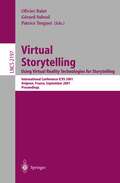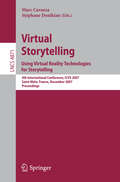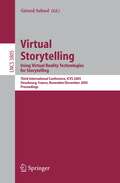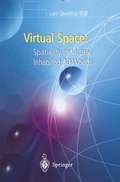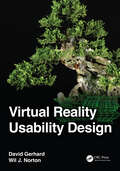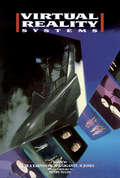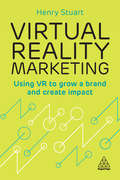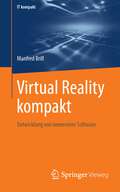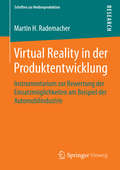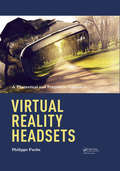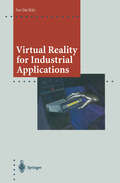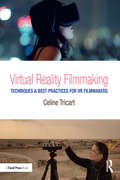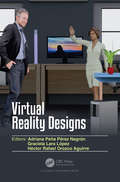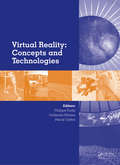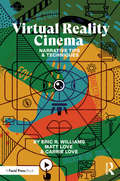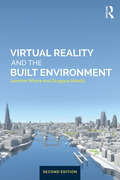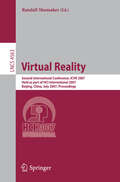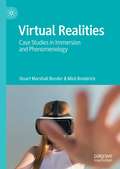- Table View
- List View
Virtual Storytelling. Using Virtual Reality Technologies for Storytelling: International Conference ICVS 2001 Avignon, France, September 27-28, 2001 Proceedings (Lecture Notes in Computer Science #2197)
by Olivier Balet Gérard Subsol Patrice TorguetThe story is the richest heritage of human civilizations. One can imagine the ?rst stories being told, several thousand centuries ago, by wise old men huddled around camp?res. Since this time, the narrative process has been considerably developed and enriched: sounds and music have been added to complement the speech, while scenery and theatrical sets have been created to enhance the story environment. Actors, dancers, and technicians have replaced the lone storyteller. The story is no longer the sole preserve of oral narrative but can be realized in book, theatrical, dance, or movie form. Even the audience can extend up to several million individuals. And yet in its many forms the story lies at the heart of one of the world’s most important industries. The advent of the digital era has enhanced and accelerated this evolution: image synthesis, digital special e?ects, new Human-Computer interfaces, and the Internet allow one not only to realize more sophisticated narrative forms but also to create new concepts such as video gaming and virtual environments. The art of storytelling is becoming evermore complex. Virtual reality o?ers new tools to capture, and to interactively modify the imaginary environment, in ever more intuitive ways, coupled with a maximum sensory feedback. In fact, virtual reality technologies o?er enhanced and exciting production possibilities for the creation and non-linear manipulation in real time, of almost any story form. This has lead to the new concept of Virtual Storytelling.
Virtual Storytelling. Using Virtual Reality Technologies for Storytelling: 4th International Conference, ICVS 2007, Saint-Malo, France, December 5-7, 2007, Proceedings (Lecture Notes in Computer Science #4871)
by Marc Cavazza Stéphane DonikianThis book constitutes the refereed proceedings of the 4th International Conference on Virtual Storytelling, ICVS 2007, held in Saint-Malo, France, in December 2007. The 12 revised full papers, three invited papers and seven poster and demo papers were carefully reviewed and selected. The papers are organized in topical sections on authoring tools and story models, behavior modeling, user interactivity, an invited session: related EU projects, as well as the poster and demo session.
Virtual Storytelling. Using Virtual Reality Technologies for Storytelling: Third International Conference, VS 2005, Strasbourg, France, November 30-December 2, 2005, Proceedings (Lecture Notes in Computer Science #3805)
by Gérard SubsolThe 1st International Conference on Virtual Storytelling took place on September 27–28, 2001, in Avignon (France) in the prestigious Popes’ Palace. Despite the tragic events of September 11 that led to some last-minute cancellations, nearly 100 people from 14 different countries attended the 4 invited lectures given by international experts, the 13 scientific talks and the 6 scientific demonstrations. Virtual Storytelling 2003 was held on November 20–21, 2003, in Toulouse (France) in the Modern and Contemporary Art Museum “Les Abattoirs.” One hundred people from 17 different countries attended the conference composed of 3 invited lectures, 16 scientific talks and 11 posters/demonstrations. Since autumn 2003, there has been strong collaboration between the two major virtual/digital storytelling conference series in Europe: Virtual Storytelling and TIDSE (Technologies for Interactive Digital Storytelling and Entertainment). Thus the conference chairs of TIDSE and Virtual Storytelling decided to establish a 2 year turnover for both conferences and to join the respective organizers in the committees. For the third edition of Virtual Storytelling, the Organization Committee chose to extend the conference to 3 days so that more research work and applications could be be presented, to renew the Scientific and Application Board, to open the conference to new research or artistic communities, and to call for the submission of full papers and no longer only abstracts so as to make a higher-level selection.
Virtual Space: Spatiality in Virtual Inhabited 3D Worlds
by J. F. Jensen E. Kjems N. Lehmann C. MadsenContaining the edited research papers resulting from an ambitious, cross-disciplinary research project, this volume examines the spatiality of virtual inhabited 3D worlds - virtual reality and cyberspace. (Three other volumes look at Interaction, Staging and Methodology.) It is about the communication spaces emerging at the Internet and supported by special 3D interfaces. It is also about the virtual spaces created by virtual reality hardware (CAVEs, panoramic screens, head mounted display systems etc.) and software.Virtual Space: Spatiality in Virtual Inhabited 3D Worlds is interdisciplinary. It deals with philosophical, psychological, communicational, technological and aesthetic aspects of space. While philosophy raises the question concerning the ontology of space - what is space - psychology deals with our perception of space. Communication theory looks at the way in which space supports communication (i.e. that space is a medium for communication), and finally aesthetic analyses exemplify the use of virtual space in virtual cities, in museums and in art.
Virtual Reality Usability Design
by David Gerhard Wil J. NortonThe development of effective and usable software for spatial computing platforms like virtual reality (VR) requires an understanding of how these devices create new possibilities (and new perils) when it comes to interactions between humans and computers. Virtual Reality Usability Design provides readers with an understanding of the techniques and technologies required to design engaging and effective VR applications. The book covers both the mechanics of how human senses and the mind experience immersive virtual environments, as well as how to leverage these mechanics to create human-focused virtual experiences. Deeply rooted in principles of human perception and computational interaction, the current and future limitations of these replacements are also considered. Full of real-world examples, this book is an indispensable guide for any practicing VR developer interested in making efficient and effective interfaces. Meanwhile, explorations of concrete theory in their practical application will be useful for VR students and researchers alike.
Virtual Reality Usability Design
by David Gerhard Wil J. NortonThe development of effective and usable software for spatial computing platforms like virtual reality (VR) requires an understanding of how these devices create new possibilities (and new perils) when it comes to interactions between humans and computers. Virtual Reality Usability Design provides readers with an understanding of the techniques and technologies required to design engaging and effective VR applications. The book covers both the mechanics of how human senses and the mind experience immersive virtual environments, as well as how to leverage these mechanics to create human-focused virtual experiences. Deeply rooted in principles of human perception and computational interaction, the current and future limitations of these replacements are also considered. Full of real-world examples, this book is an indispensable guide for any practicing VR developer interested in making efficient and effective interfaces. Meanwhile, explorations of concrete theory in their practical application will be useful for VR students and researchers alike.
Virtual Reality Systems
by R. A. EarnshawThis volume brings together a number of the leading practitioners and exponents in the field of virtual reality (VR), and explores some of the main issues in the area and its associated hardware and software technology. The main components of the current generation of virtual reality systems are outlined, and major developments of VR systems are discussed.* SPECIAL FEATURES* This volume brings together some of the leading practitioners and exponents in the field of VR, and explores some of the main issues in the area and its associated hardware and software technology.* The main components of the current generation of cirtual reality systems are outlined, and major developments of Vr systems are discussed, focussing of key areas such as hardware, software, techniques, application interfaces and ethical issues.* The book contains a comprehensive bibliography enabling the reader to follow up particular areas of specialism. It contains 16 pages of colour plates.
Virtual Reality Marketing: Using VR to Grow a Brand and Create Impact
by Henry StuartIf a picture is worth a thousand words, then virtual reality (VR) is priceless. This new medium is booming - by 2025, the industry is expected to become bigger than TV. Virtual Reality Marketing is a comprehensive exploration of all things VR, providing readers with everything they need to know about the current VR landscape, and the unprecedented opportunity it offers brands to create unique emotional connections with consumers. A truly comprehensive guide, Virtual Reality Marketing covers all aspects of the industry, including interactive and passive VR, 360 video, social VR marketing, and the role that influencers and bloggers are set to play in its development. It also looks to the future - exploring how VR is evolving and the changes it will undergo in the future. Virtual Reality Marketing is the only complete guide to VR marketing available, written by a recognized industry expert who has facilitated VR coverage for major international brands including Facebook, Audi, Google and Mercedes F1. Packed with fascinating case studies, tips and strategies, this text is the leading resource for any reader looking to incorporate VR in their own marketing campaigns.
Virtual Reality Marketing: Using VR to Grow a Brand and Create Impact
by Henry StuartIf a picture is worth a thousand words, then virtual reality (VR) is priceless. This new medium is booming - by 2025, the industry is expected to become bigger than TV. Virtual Reality Marketing is a comprehensive exploration of all things VR, providing readers with everything they need to know about the current VR landscape, and the unprecedented opportunity it offers brands to create unique emotional connections with consumers. A truly comprehensive guide, Virtual Reality Marketing covers all aspects of the industry, including interactive and passive VR, 360 video, social VR marketing, and the role that influencers and bloggers are set to play in its development. It also looks to the future - exploring how VR is evolving and the changes it will undergo in the future. Virtual Reality Marketing is the only complete guide to VR marketing available, written by a recognized industry expert who has facilitated VR coverage for major international brands including Facebook, Audi, Google and Mercedes F1. Packed with fascinating case studies, tips and strategies, this text is the leading resource for any reader looking to incorporate VR in their own marketing campaigns.
Virtual Reality kompakt: Entwicklung von immersiver Software (IT kompakt)
by Manfred BrillVirtual Reality ist immer noch eine Technologie, die sich extrem schnell verändert. Ständig wird neue Hardware entwickelt, die neue Anwendungen hervorbringt und die Weiterentwicklung der dafür nötigen Softwaren erzwingt. Die Themen Immersion, Interaktivität und die Gestaltung des User Interfaces in einer immersiven Anwendung haben au den Konferenzen wie der IEEE VR oder der ISMAR immer noch einen großen Stellenwert.Dieses Buch konzentriert sich auf die Software-Entwicklung von VR-Anwendungen. Dabei werden Werkzeuge aus der Praxis wie Unity, Unreal und andere frei verfügbare SDKs vorgestellt und in Fallstudien eingesetzt. Nach einer Einführung in die Grundlagen der virtuellen Realität konzentrieren wir uns auf allgemeine Aspekte der Software-Entwicklung. Hauptthema sind Portabilität am Beispiel von OpenXR und generische und wiederverwendbare Bausteine für die Implementierung von Benutzungsoberflächen. Wie wir diese Bausteine in den Werkzeugen vorfinden oder selbst implementieren ist anschließend das Thema. Letztendlich werden die Leser ein eigenes Framework für diese Techniken entwickeln, die anschließend in den eigenen Anwendungen verwendet werden können. Die Lösungen der Aufgaben, insbesondere die Quelltexte der vorgestellten Software sind in einem öffentlichen GitHub-Repository verfügbar. Im letzten Abschnitt des Buchs werden immersive Anwendungen im Bereich der Strömungsdynamik, der Volumengrafik und des Immersive Learnings vorgestellt, realisiert und weiter entwickelt.
Virtual Reality in der Produktentwicklung: Instrumentarium zur Bewertung der Einsatzmöglichkeiten am Beispiel der Automobilindustrie (Schriften zur Medienproduktion)
by Martin H. RademacherDie virtuelle Entwicklung ist als wesentlicher Bestandteil im Entwicklungsprozess neuer Produkte etabliert. Virtual Reality (VR) – ein Teilbereich der virtuellen Entwicklung – bietet die Möglichkeit, durch schnelle Visualisierung und freie Interaktion die Designfindung zu unterstützen, Ergonomie- und Montageuntersuchungen durchzuführen sowie Entwicklungsstände frühzeitig auf Fehler zu untersuchen. Martin Rademacher entwickelt ein Vorgehensmodell, mit dem sich die Einsatzfähigkeit der VR für Fragestellungen im automobilen Entwicklungsprozess in einem nutzer- und aufgabenzentrierten Kontext untersuchen lässt und wendet es auf den Aufgabenbereich „Absicherung der Anmutung und Qualität“ in einem Automobilunternehmen an.
Virtual Reality Headsets - A Theoretical and Pragmatic Approach
by Philippe FuchsThe purpose of virtual reality is to make possible a sensorimotor and cognitive activity for a user in a digitally created artificial world. Recent advances in computer technology have led to a new generation of VR devices such as VR headsets. Accordingly, virtual reality poses many new scientific challenges for researchers and professionals. The aim of this book, a manual meant for both designers and users of virtual reality, is to present the current state of knowledge on the use of VR headsets in the most complete way possible. The book is divided into 13 chapters. The objective of the first chapter is to give an introduction to VR and clarify its scope. The next chapter presents a theoretical approach to virtual reality through our Immersion and Interaction methodology also known as "3I² model’’. Then, a chapter about human senses is necessary to understand the sensorimotor immersion, especially vision. These chapters are followed by several chapters which present the different visual interfaces and the VR headsets currently available on the market. These devices can impart comfort and health problems due to sensorimotor discrepancies. A chapter is devoted to these problems, followed by a chapter that gives a detailed discussion of methods and 32 solutions to dispel, or at least to decrease, VR sickness. The following three chapters present different VR applications that use VR headsets (behavioural sciences, industrial uses and Digital Art) and the final chapter provides conclusions and discusses future VR challenges.
Virtual Reality Headsets - A Theoretical and Pragmatic Approach
by Philippe FuchsThe purpose of virtual reality is to make possible a sensorimotor and cognitive activity for a user in a digitally created artificial world. Recent advances in computer technology have led to a new generation of VR devices such as VR headsets. Accordingly, virtual reality poses many new scientific challenges for researchers and professionals. The aim of this book, a manual meant for both designers and users of virtual reality, is to present the current state of knowledge on the use of VR headsets in the most complete way possible. The book is divided into 13 chapters. The objective of the first chapter is to give an introduction to VR and clarify its scope. The next chapter presents a theoretical approach to virtual reality through our Immersion and Interaction methodology also known as "3I² model’’. Then, a chapter about human senses is necessary to understand the sensorimotor immersion, especially vision. These chapters are followed by several chapters which present the different visual interfaces and the VR headsets currently available on the market. These devices can impart comfort and health problems due to sensorimotor discrepancies. A chapter is devoted to these problems, followed by a chapter that gives a detailed discussion of methods and 32 solutions to dispel, or at least to decrease, VR sickness. The following three chapters present different VR applications that use VR headsets (behavioural sciences, industrial uses and Digital Art) and the final chapter provides conclusions and discusses future VR challenges.
Virtual Reality for Industrial Applications (Computer Graphics: Systems and Applications)
by Fan DaiJust a few years ago, virtual reality was regarded as more a toy than a tool. Today, however, it is becoming the enabling technology for man-machine communications. The rapid development of graphics hardware and soft ware makes its application possible. Besides building walkthroughs and landscape fly-overs with very realistic visual effects, we can recognize the trend toward industrial applications. This is because of the emerging need for tools for rapid product development. Especially in the aeronautical and automotive industries, companies have began to investigate and develop virtual reality tools for their own needs in co-operation with research or ganizations. In co-operation with the Fraunhofer Institute for Computer Graphics (IGD), the Computer Graphics Center (ZGDV) in Darmstadt established the German working group on virtual reality in 1993 as a forum for infor mation exchange between industry and research. German researchers, system developers, and industrial users have met several times in Darm stadt at the Computer Graphics Center. In these meetings they discussed the essential issues inherent in applying virtual reality to industrial appli cations and exchanged their latest research results and experiences.
Virtual Reality Filmmaking: Techniques & Best Practices for VR Filmmakers
by Celine TricartVirtual Reality Filmmaking presents a comprehensive guide to the use of virtual reality in filmmaking, including narrative, documentary, live event production, and more. Written by Celine Tricart, a filmmaker and an expert in new technologies, the book provides a hands-on guide to creative filmmaking in this exciting new medium, and includes coverage on how to make a film in VR from start to finish. Topics covered include: The history of VR; VR cameras; Game engines and interactive VR; The foundations of VR storytelling; Techniques for shooting in live action VR; VR postproduction and visual effects; VR distribution; Interviews with experts in the field including the Emmy-winning studios Felix & Paul and Oculus Story Studio, Wevr, Viacom, Fox Sports, Sundance’s New Frontier, and more.
Virtual Reality Filmmaking: Techniques & Best Practices for VR Filmmakers
by Celine TricartVirtual Reality Filmmaking presents a comprehensive guide to the use of virtual reality in filmmaking, including narrative, documentary, live event production, and more. Written by Celine Tricart, a filmmaker and an expert in new technologies, the book provides a hands-on guide to creative filmmaking in this exciting new medium, and includes coverage on how to make a film in VR from start to finish. Topics covered include: The history of VR; VR cameras; Game engines and interactive VR; The foundations of VR storytelling; Techniques for shooting in live action VR; VR postproduction and visual effects; VR distribution; Interviews with experts in the field including the Emmy-winning studios Felix & Paul and Oculus Story Studio, Wevr, Viacom, Fox Sports, Sundance’s New Frontier, and more.
Virtual Reality Designs
by Adriana Peña Pérez Negrón; Graciela Lara López; Héctor Rafael Orozco AguirreVirtual Reality is not real life. Instead it is life-like creations using computer-generated scenarios. Human behavior is replicated in virtual scenarios, where every detail is controlled by computers, and in situations that can be repeated under the same conditions. Based on technology and design, the user can experience presence. In the virtual world, users are embodied in avatars that represent them and are the means to interact with the virtual environment. Avatars are graphical models that behave on behalf of the human behind them. The user avatar is a proxy that also backs interaction with others, allowing computer-mediated interactions. Analyses directed to understand people’s perceptions, personal and social behavior in computer mediated interactions, comprise a multidisciplinary area of study that involves, among others, computer science, psychology and sociology. In the last two decades a number of studies supported by Virtual Reality have been conducted to understand human behavior, in some cases the implications of the technology, or to reproduce artificial human behavior. This book presents a collection of studies from recognized researchers in the area.
Virtual Reality Designs
by Adriana Peña Pérez Negrón Graciela Lara López Héctor Rafael Orozco AguirreVirtual Reality is not real life. Instead it is life-like creations using computer-generated scenarios. Human behavior is replicated in virtual scenarios, where every detail is controlled by computers, and in situations that can be repeated under the same conditions. Based on technology and design, the user can experience presence. In the virtual world, users are embodied in avatars that represent them and are the means to interact with the virtual environment. Avatars are graphical models that behave on behalf of the human behind them. The user avatar is a proxy that also backs interaction with others, allowing computer-mediated interactions. Analyses directed to understand people’s perceptions, personal and social behavior in computer mediated interactions, comprise a multidisciplinary area of study that involves, among others, computer science, psychology and sociology. In the last two decades a number of studies supported by Virtual Reality have been conducted to understand human behavior, in some cases the implications of the technology, or to reproduce artificial human behavior. This book presents a collection of studies from recognized researchers in the area.
Virtual Reality: Concepts and Technologies
by Philippe Fuchs Guillaume Moreau Pascal GuittonA manual for both designers and users, comprehensively presenting the current state of experts' knowledge on virtual reality (VR) in computer science, mechanics, optics, acoustics, physiology, psychology, ergonomics, ethics, and related area. Designed as a reference book and design guide to help the reader develop a VR project, it presents the read
Virtual Reality Cinema: Narrative Tips and Techniques
by Eric R. Williams Carrie Love Matt LoveAward-winning cine-maVRicks Eric R. Williams, Carrie Love and Matt Love introduce virtual reality cinema (also known as 360° video or cine-VR) in this comprehensive guide filled with insider tips and tested techniques for writing, directing and producing effectively in the new medium. Join these veteran cine-VR storytellers as they break down fundamental concepts from traditional media to demonstrate how cine-VR can connect with audiences in new ways. Examples from their professional work are provided to illustrate basic, intermediate and advanced approaches to crafting modern story in this unique narrative space where there’s no screen to contain an image and no specific stage upon which to perform. Virtual Reality Cinema will prepare you to approach your own cine-VR projects via: Tips and techniques for writing, directing and producing bleeding-edge narrative cine-VR projects; More than a hundred photos and illustrations to explain complex concepts; Access to more than two hours of on-line cine-VR examples that you can download to watch on your own HMD; New techniques developed at Ohio University’s Game Research and Immersive Design (GRID) Lab, including how to work with actors to embrace Gravity and avoid the Persona Gap, how to develop stories with the Story Engagement Matrix and how to balance directorial control and audience agency in this new medium. This book is an absolute must read for any student of filmmaking, media production, transmedia storytelling and game design, as well as anyone already working in these industries that wants to understand the new challenges and opportunities of virtual reality cinema.
Virtual Reality Cinema: Narrative Tips and Techniques
by Eric R. Williams Carrie Love Matt LoveAward-winning cine-maVRicks Eric R. Williams, Carrie Love and Matt Love introduce virtual reality cinema (also known as 360° video or cine-VR) in this comprehensive guide filled with insider tips and tested techniques for writing, directing and producing effectively in the new medium. Join these veteran cine-VR storytellers as they break down fundamental concepts from traditional media to demonstrate how cine-VR can connect with audiences in new ways. Examples from their professional work are provided to illustrate basic, intermediate and advanced approaches to crafting modern story in this unique narrative space where there’s no screen to contain an image and no specific stage upon which to perform. Virtual Reality Cinema will prepare you to approach your own cine-VR projects via: Tips and techniques for writing, directing and producing bleeding-edge narrative cine-VR projects; More than a hundred photos and illustrations to explain complex concepts; Access to more than two hours of on-line cine-VR examples that you can download to watch on your own HMD; New techniques developed at Ohio University’s Game Research and Immersive Design (GRID) Lab, including how to work with actors to embrace Gravity and avoid the Persona Gap, how to develop stories with the Story Engagement Matrix and how to balance directorial control and audience agency in this new medium. This book is an absolute must read for any student of filmmaking, media production, transmedia storytelling and game design, as well as anyone already working in these industries that wants to understand the new challenges and opportunities of virtual reality cinema.
Virtual Reality and the Built Environment
by Jennifer Whyte Dragana NikolićLike the first edition, the central question this book addresses is how virtual reality can be used in the design, production and management of the built environment. The book aims to consider three key questions. What are the business drivers for the use of virtual reality? What are its limitations? How can virtual reality be implemented within organizations? Using international case studies it answers these questions whilst addressing the growth in the recent use of building information modelling (BIM) and the renewed interest in virtual reality to visualize and understand data to make decisions. With the aim of inspiring and informing future use, the authors take a fresh look at current applications in the construction sector, situating them within a broader trajectory of innovation. The new edition expands the scope to consider both immersive virtual reality as a way of bringing professionals inside a building information model, and augmented reality as a way of taking this model and related asset information out to the job-site. The updated edition also considers these technologies in the context of other developments that were in their infancy when the first edition was written – such as laser scanning, mobile technologies and big data. Virtual Reality in the Built Environment is essential reading for professionals in architecture, construction, design, surveying and engineering and students on related courses who need an understanding of BIM, CAD and virtual reality in the sector. Please follow the book's Twitter account: @vrandbe http://buildingvr.blogspot.co.uk/
Virtual Reality and the Built Environment
by Jennifer Whyte Dragana NikolićLike the first edition, the central question this book addresses is how virtual reality can be used in the design, production and management of the built environment. The book aims to consider three key questions. What are the business drivers for the use of virtual reality? What are its limitations? How can virtual reality be implemented within organizations? Using international case studies it answers these questions whilst addressing the growth in the recent use of building information modelling (BIM) and the renewed interest in virtual reality to visualize and understand data to make decisions. With the aim of inspiring and informing future use, the authors take a fresh look at current applications in the construction sector, situating them within a broader trajectory of innovation. The new edition expands the scope to consider both immersive virtual reality as a way of bringing professionals inside a building information model, and augmented reality as a way of taking this model and related asset information out to the job-site. The updated edition also considers these technologies in the context of other developments that were in their infancy when the first edition was written – such as laser scanning, mobile technologies and big data. Virtual Reality in the Built Environment is essential reading for professionals in architecture, construction, design, surveying and engineering and students on related courses who need an understanding of BIM, CAD and virtual reality in the sector. Please follow the book's Twitter account: @vrandbe http://buildingvr.blogspot.co.uk/
Virtual Reality: Second International Conference, ICVR 2007, Held as Part of HCI International 2007, Beijing, China, July 22-27, 2007, Proceedings (Lecture Notes in Computer Science #4563)
by Randall ShumakerThis book constitutes the refereed proceedings of the Second International Conference on Virtual Reality, ICVR 2007, held in Beijing, China. It covers 3D rendering and visualization, interacting and navigating in virtual and augmented environments, industrial applications of virtual reality, as well as health, cultural, educational and entertainment applications.
Virtual Realities: Case Studies in Immersion and Phenomenology
by Stuart Marshall Bender Mick BroderickVirtual Realities presents a ground-breaking application of phenomenology as a critical method to explore the impact of immersive media. Specific case studies examine 360-degree documentary productions about trauma, virtual military simulations, VR exposure therapy for anxiety and posttraumatic stress disorder, and the emerging debate about regulating violent content in immersive media gaming. By addressing these texts primarily as experiences, Virtual Realities deploys an analytic and critical methodology that is sensitive to the bodily and cognitive impact of immersive media, especially via the body of an appropriately attentive researcher-critic. Virtual Realities provokes a rethinking of many of the taken-for-granted ideas and assumptions circulating in the field of immersive media. These include concepts of empathy, embodiment, the affective impact of textual and immersive properties on the users’ experience, as well as the “gee-whizz” mentality often associated with approaches to the medium. The case studies provide fresh engagement with immersive media such as cinematic VR at a time when dominant attitudes about the technology display an evangelical fascination with VR and other mixed realities as inexorably beneficial. Virtual Realities makes a compelling case for VR-phenomenology to be employed as a methodology by humanities scholars and also in cross-disciplinary applications of immersive media in fields such as psychology, human-computer interaction studies and the health sciences.
